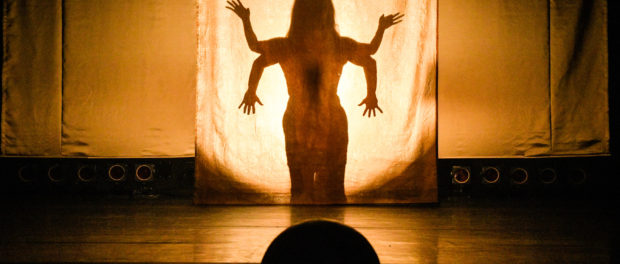Tlakentli Explores Identity Lost and Found
By Jamie Le Tual and Rachel Levine
Tlakentli is about identity, both lost and found.
An interpretive dance piece that spans from an ancient creation myth all the way to modern day diaspora, the piece offers vignettes of cultural and personal identities that are sometimes sought, sometimes forced, all against the backdrop of colonialism in the Americas.
The theatrical dance piece is accompanied by a multi instrumentalist who plays everything from drums and shakers to Spanish guitar. The music is percussive, as are the few lines of dialogue which punctuate the dance.
The show begins as if an Aztec wall-carving of a creation myth has come to life. With angular elbows and knees, deep squats, and precise movements, the dancers (Leticia Vera and Carlos Rivera) act out a metaphoric evolution. They shift from an almost sea-like opening with their arms swaying like seaweed and fingers wiggling like schools of fish, to a playful evolution of land creatures (perhaps reptilian, perhaps simian) playing with a ball. This more naturalistic vignette comes to an end as the projection of an erupting volcano fills the screen behind. Rivera cradles a shaking Vera in his arms. The two share their fate, as partners and playmates.

As the piece progresses, this relationship is rent as colonization’s effects take their toll. The two don clothing and with it come power-struggles and a manic happiness that masks suffering. Oversize smiles, comedic-styled scenes of physical abuse, and frantic dance suggest a past that can only be viewed incompletely from the present. This is further achieved through the sepia tones and stylized posturing, that recall old photographs and film. On the screen behind, photographs of families appear.
At last the show journeys from the past to the more proximate. The two are in Canada where the wonder of snow is balanced against the fact that even here, far from the violence and romance of Mexico, indigenous peoples are still caught in colonization’s web.

The piece makes use of costume and multiple languages (English, French, Spanish, and Nahuatl) to capture the way in which colonization both restricts and molds its victims. Towards the end of the piece, the two begin to strip clothing from their bodies, piece by piece, giving some explanation as to the origin of the show in the limited family mythology that survives.
The piece references works of art over time by artists who study identity and genocide, such as Mexican muralist José Clemente Orozco and the REDress project. In one of the black and white photos projected on the screen behind the performance, a red colourized dress on Vera’s grandmother recalls Steven Spielberg’s technique of using red on a little girls’ jacket in Schindler’s List as a way to show the inescapability of genocide.
Rather than having left with a feeling of resolution, the show gives witness to a statement, a “compte rendu”, of the time line and lasting effects of colonialism as well as an acknowledgement that it is still occurring. And so, appropriately, rather than offer solutions, it offers a narrative that is part of the larger picture, and serves as a point of departure for the social dialogue that as a society we must all have about – and with – indigenous peoples.
Tlakelntli was performed at Cinquieme Salle on March 14-16. More information can be found HERE.






